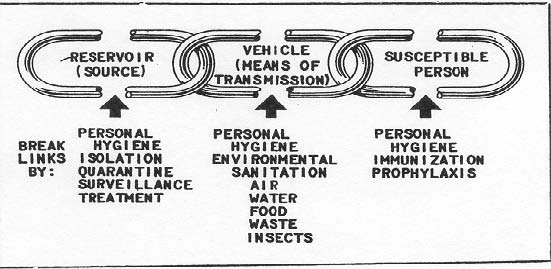Principles of Epidemiology and Microbiology
Lesson
1: Introduction to Disease Transmission and Epidemiology
1-11
1-11. COMMUNICABLE DISEASE CONTROL
Disease control measures may be viewed as a means of breaking the links to the chain of disease transmission (figure 1-2). If anyone of the links in the chain is broken, disease will not occur. The infection chain for each specific disease usually has one link that is more vulnerable or more easily broken than the others. While the chain may be attacked at several points and all three links, the major effort usually is made against the weakest link. The one disease control measure that is applicable to all three links is personal hygiene. Personal hygiene is defined as the application, by the individual, of the principles of healthful living. It embraces more than mere personal cleanliness. Achieving a high level of personal hygiene requires the individual to practice health rules to safeguard his own health and the health of others. Every individual is potentially a source of disease, a vehicle of transmission, and a person susceptible (to a greater or lesser degree) to disease. Therefore, universal and unrelenting application of the principles of healthful living will do much to prevent the spread of disease.
Figure 1-2. Break the chain of disease transmission.
a. Control Measures Applicable to the Source.
(1) Isolation is the separation of infected persons from others during the period in which the infection is communicable. This separation may be accomplished by having the sick person admitted to hospital isolation or by self-isolation practiced by the infected person. In self-isolation the infected person should separate himself from susceptible by a distance of more than 5 feet, practice good personal hygiene, and avoid the spreading of disease agents as much as possible.
(2) Quarantine is the restriction of movement of a well person who has been exposed to a communicable disease. The purpose of quarantine is to prevent contact between a probable carrier and other people who have not been exposed.
(3) Medical surveillance consists of observing and supervising someone who, through association with a disease source, may have been exposed to a disease.
Surveillance of these contacts permits early recognition of disease without restriction of movement. In the presence of a threatened epidemic, examination of all troops may be ordered.
(4) Prompt and adequate treatment of disease sources assists in the destruction of the infectious agent and subsequent reduction in the reservoir of disease agents.
b. Control Methods Applicable to the Mode of Transmission. Air, food, water, clothing, bedding, waste, people, and various forms of animal life in the environment have the capacity to transmit communicable disease agents. Environmental sanitation is essential for the control of transmitting agents. The following principles are included in environmental sanitation:
(1) Good personal hygiene by each individual.
(2) Avoidance of overcrowding and close physical contact.
(3) Proper ventilation of living quarters.
(4) Water purification.
(5) Careful selection and preparation of food.
(6) Maintenance of food service sanitation.
(7) Sanitary waste disposal.
(8) Proper control of disease-carrying insects and animals.
c. Control Methods Applicable to the Susceptible Person. A "susceptible" or "non-immune" is a person who has little resistance against a particular disease organism and who, if exposed to this organism, is liable to contract the disease. Protection of the susceptible requires use of all measures necessary to maintain or improve general health. The individual who has good mental and physical health has good resistance to disease. Good personal hygiene, including avoidance of known or suspected sources of disease, helps maintain health. A number of immunizing agents are available for use in conjunction with other measures for the control of some, but not all, communicable diseases. In some instances, suppressive drugs are available to decrease the severity of disease.


